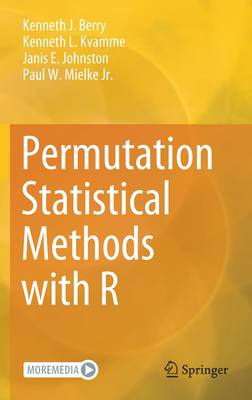
- Afhalen na 1 uur in een winkel met voorraad
- Gratis thuislevering in België vanaf € 30
- Ruim aanbod met 7 miljoen producten
- Afhalen na 1 uur in een winkel met voorraad
- Gratis thuislevering in België vanaf € 30
- Ruim aanbod met 7 miljoen producten
Permutation Statistical Methods with R
Kenneth J Berry, Kenneth L Kvamme, Janis E Johnston, Paul W Mielke JrOmschrijving
This book takes a unique approach to explaining permutation statistics by integrating permutation statistical methods with a wide range of classical statistical methods and associated R programs. It opens by comparing and contrasting two models of statistical inference: the classical population model espoused by J. Neyman and E.S. Pearson and the permutation model first introduced by R.A. Fisher and E.J.G. Pitman. Numerous comparisons of permutation and classical statistical methods are presented, supplemented with a variety of R scripts for ease of computation. The text follows the general outline of an introductory textbook in statistics with chapters on central tendency and variability, one-sample tests, two-sample tests, matched-pairs tests, completely-randomized analysis of variance, randomized-blocks analysis of variance, simple linear regression and correlation, and the analysis of goodness of fit and contingency.
Unlike classical statistical methods, permutation statistical methods do not rely on theoretical distributions, avoid the usual assumptions of normality and homogeneity, depend only on the observed data, and do not require random sampling. The methods are relatively new in that it took modern computing power to make them available to those working in mainstream research.Designed for an audience with a limited statistical background, the book can easily serve as a textbook for undergraduate or graduate courses in statistics, psychology, economics, political science or biology. No statistical training beyond a first course in statistics is required, but some knowledge of, or some interest in, the R programming language is assumed.
Specificaties
Betrokkenen
- Auteur(s):
- Uitgeverij:
Inhoud
- Aantal bladzijden:
- 660
- Taal:
- Engels
Eigenschappen
- Productcode (EAN):
- 9783030743604
- Verschijningsdatum:
- 28/09/2021
- Uitvoering:
- Hardcover
- Formaat:
- Genaaid
- Afmetingen:
- 156 mm x 234 mm
- Gewicht:
- 1129 g

Alleen bij Standaard Boekhandel
Beoordelingen
We publiceren alleen reviews die voldoen aan de voorwaarden voor reviews. Bekijk onze voorwaarden voor reviews.









